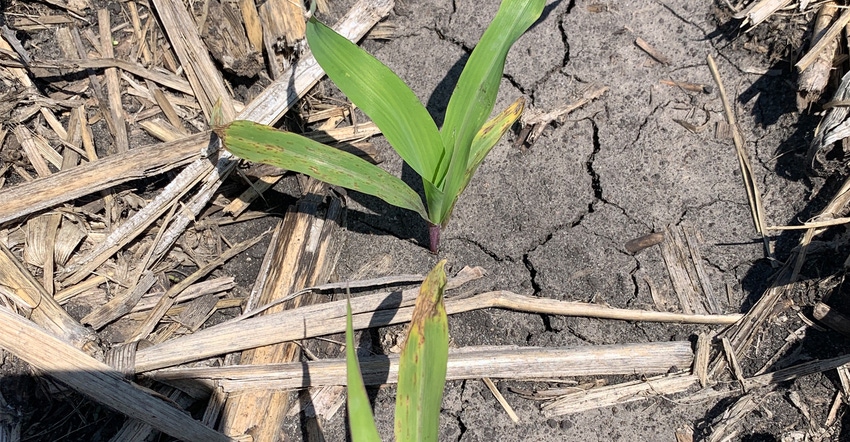June 8, 2020

Symptoms of anthracnose leaf blight are evident on the bottom leaves of young corn plants in some corn-on-corn fields in Iowa in early June. This disease showing up early on these fields was no surprise to Alison Robertson, Iowa State University Extension plant pathologist.
“Corn residue is a source of inoculum,” she says. “What do I mean by that? The fungus that causes anthracnose leaf blight survives in corn crop residue. When conditions are wet in the spring, the fungus produces spores in a gelatinous matrix on the residue. Rain drops from spring rains splash the spores onto nearby corn seedlings.”
A study in Wisconsin several years ago reported a positive association between corn residue cover in the spring and anthracnose leaf blight. Anthracnose leaf blight is usually not observed on corn-on-soybean fields, but it is fairly common on continuous corn.
Leaf blight vs. stalk rot
Some growers are wondering whether the incidence of anthracnose leaf blight early in the growing season is a signal that stalk rot will be a problem with the corn in these same fields later, as the crop approaches harvesttime.
The fungus that causes anthracnose leaf blight in the spring, also causes stalk rot at the end of the growing season. “However, the Wisconsin study found no relationship between anthracnose leaf blight and stalk rot,” Robertson says. “In other words, just because anthracnose leaf blight is present in a field, this does not mean that stalk rot will be a problem. There are a couple of reasons why this may be so.”
Resistance to anthracnose leaf blight and resistance to stalk rot are controlled by different genes. Thus, a field where anthracnose leaf blight is prevalent may not have stalk rot issues at the end of the season if the corn hybrid has resistance to the anthracnose fungus. The Wisconsin study reported stalk rot incidence (percent of plants with stalk rot symptoms) was greater in plots that were chisel-plowed compared to no-till plots. Another study conducted in Texas found the fungus entered through corn roots and caused a systemic infection.
Since there was no relationship between leaf blight and stalk rot in the Wisconsin study, the researchers suggested that chisel plowing, which buries anthracnose-infested residue and puts it in the vicinity of corn roots, may contribute to stalk rot. More research is needed to understand what the source of inoculum is for anthracnose stalk rot, Robertson says.
Apply foliar fungicide?
Farmers are asking, should they include a fungicide in the tankmix with their postemergence herbicide to try to control anthracnose leaf blight? “The answer is no,” Robertson says.
She explains, “In my experience, once we get to canopy closure in a field of corn, it is rare to see anthracnose leaf blight in Iowa. The bottom five leaves on the plants that do get infected as a seedling will die and these leaves do not contribute to corn yield. Moreover, as we’ve discussed previously, there is little evidence these anthracnose infected leaves contribute to stalk rot either.”
“The second factor I would consider is that several years of studies across the U.S. have reported little yield benefit to applying a fungicide. A major study by researchers at several universities in 2019 found the mean yield response observed from an application of a fungicide at VT stage of corn growth (tasseling time) was 2.9 times greater than an application at V6, which is the vegetative stage. Consequently, the probability of return on investment from a fungicide application at VT was greater than one at V6.”
Source: ISU, which is solely responsible for the information provided and is wholly owned by the source. Informa Business Media and all its subsidiaries are not responsible for any of the content contained in this information asset.
You May Also Like




